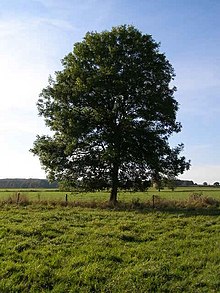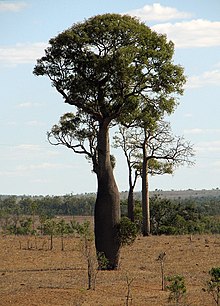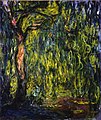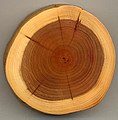Portal:Trees
The Trees Portal

In botany, a tree is a perennial plant with an elongated stem, or trunk, usually supporting branches and leaves. In some usages, the definition of a tree may be narrower, including only woody plants with secondary growth, plants that are usable as lumber or plants above a specified height. In wider definitions, the taller palms, tree ferns, bananas, and bamboos are also trees.
Trees are not a monophyletic taxonomic group but consist of a wide variety of plant species that have independently evolved a trunk and branches as a way to tower above other plants to compete for sunlight. The majority of tree species are angiosperms or hardwoods; of the rest, many are gymnosperms or softwoods. Trees tend to be long-lived, some reaching several thousand years old. Trees evolved around 370 million years ago, and it is estimated that there are around three trillion mature trees in the world currently.
A tree typically has many secondary branches supported clear of the ground by the trunk, which typically contains woody tissue for strength, and vascular tissue to carry materials from one part of the tree to another. For most trees the trunk is surrounded by a layer of bark which serves as a protective barrier. Below the ground, the roots branch and spread out widely; they serve to anchor the tree and extract moisture and nutrients from the soil. Above ground, the branches divide into smaller branches and shoots. The shoots typically bear leaves, which capture light energy and convert it into sugars by photosynthesis, providing the food for the tree's growth and development.
Trees usually reproduce using seeds. Flowers and fruit may be present, but some trees, such as conifers, instead have pollen cones and seed cones. Palms, bananas, and bamboos also produce seeds, but tree ferns produce spores instead.
Trees play a significant role in reducing erosion and moderating the climate. They remove carbon dioxide from the atmosphere and store large quantities of carbon in their tissues. Trees and forests provide a habitat for many species of animals and plants. Tropical rainforests are among the most biodiverse habitats in the world. Trees provide shade and shelter, timber for construction, fuel for cooking and heating, and fruit for food as well as having many other uses. In much of the world, forests are shrinking as trees are cleared to increase the amount of land available for agriculture. Because of their longevity and usefulness, trees have always been revered, with sacred groves in various cultures, and they play a role in many of the world's mythologies. (Full article...)

Brachychiton rupestris (commonly known as the narrow-leaved bottle tree or Queensland bottle tree) is a tree in the family Malvaceae, endemic to Queensland, Australia. Described by Sir Thomas Mitchell and John Lindley in 1848, it earned its name from its bulbous trunk, which can be up to 3.5 metres (11 ft) in diameter at breast height (DBH). Reaching around 10–25 m (33–82 ft) high, the Queensland bottle tree is deciduous, losing its leaves seasonally, between September and December. The leaves are simple or divided, with one or more narrow leaf blades up to 11 centimetres (4 in) long and 2 cm (0.8 in) wide. Cream-coloured flowers appear from September to November, and are followed by woody, boat-shaped follicles that ripen from November to May. No subspecies are recognised.
As a drought deciduous succulent tree, much like the baobab (Adansonia) of Madagascar, B. rupestris adapts readily to cultivation, and is quite tolerant of a range of soils and temperatures. It is a key component and emergent tree in the endangered central semi-evergreen vine thickets (also known as bottletree scrub) of the Queensland Brigalow Belt. Remnant trees are often left by farmers on cleared land for their value as shade and fodder trees, and as homes for various birds and animals. (Full article...)Did you know? -
- ... that the Top 10 New Species of the past year include a 40 foot (12 m) tall tree (pictured), a crustacean that looks like a skeleton, a protist that acts like a sponge, and a fungus named after the King of the Netherlands?
- ... that the Pass Christian Light was deactivated in part because neighboring property owners refused to trim their trees?
- ... that Cossinia trifoliata trees endemic to New Caledonia have become vulnerable to extinction, according to the International Union for Conservation of Nature's 1998 assessment?
- ... that the Hanlon Expressway is named after Felix Hanlon, who helped cut the first tree to inaugurate Guelph, Ontario?
- ... that British architect Richard Feilden was killed by a falling tree whilst creating a woodland memorial for his recently deceased father?
- ... that according to tradition the Church of the Holy Archangels, Rogoz was built from two huge elm trees?
- ... that the oak tree under which Goethe allegedly wrote Faust's Walpurgis Night scene stood inside Buchenwald concentration camp and was sketched by French Volontaires de la Liberté member and camp inmate Léon Delarbre?
Selected article -

Mahogany is a straight-grained, reddish-brown timber of three tropical hardwood species of the genus Swietenia, indigenous to the Americas and part of the pantropical chinaberry family, Meliaceae. Mahogany is used commercially for a wide variety of goods, due to its coloring and durable nature. It is naturally found within the Americas, but has also been imported to plantations across Asia and Oceania. The mahogany trade may have begun as early as the 16th century and flourished in the 17th and 18th centuries. In certain countries, mahogany is considered an invasive species.
Mahogany is wood from any of three tree species: Honduran or big-leaf mahogany (Swietenia macrophylla), West Indian or Cuban mahogany (Swietenia mahagoni), and Swietenia humilis. Honduran mahogany is the most widespread and the only genuine mahogany species commercially grown today. Mahogany is a valuable lumber used for paneling, furniture, boats, musical instruments, and other items. The United States is the leading importer of mahogany, while Peru is the largest exporter. Mahogany is the national tree of the Dominican Republic and Belize. (Full article...)General images
Selected lists
Subcategories
Related portals
Associated Wikimedia
The following Wikimedia Foundation sister projects provide more on this subject:
-
Commons
Free media repository -
Wikibooks
Free textbooks and manuals -
Wikidata
Free knowledge base -
Wikinews
Free-content news -
Wikiquote
Collection of quotations -
Wikisource
Free-content library -
Wikispecies
Directory of species -
Wikiversity
Free learning tools -
Wiktionary
Dictionary and thesaurus














































































